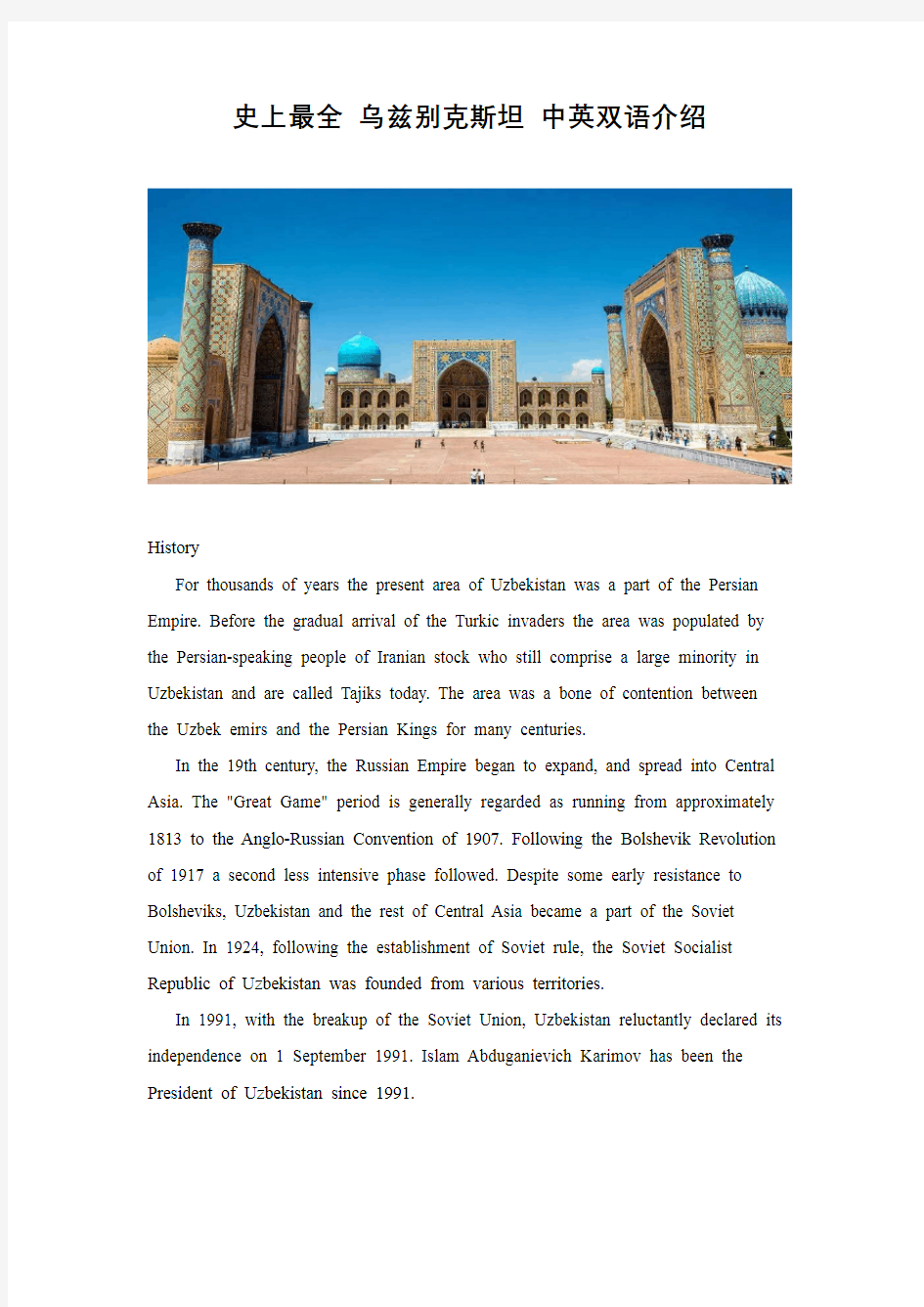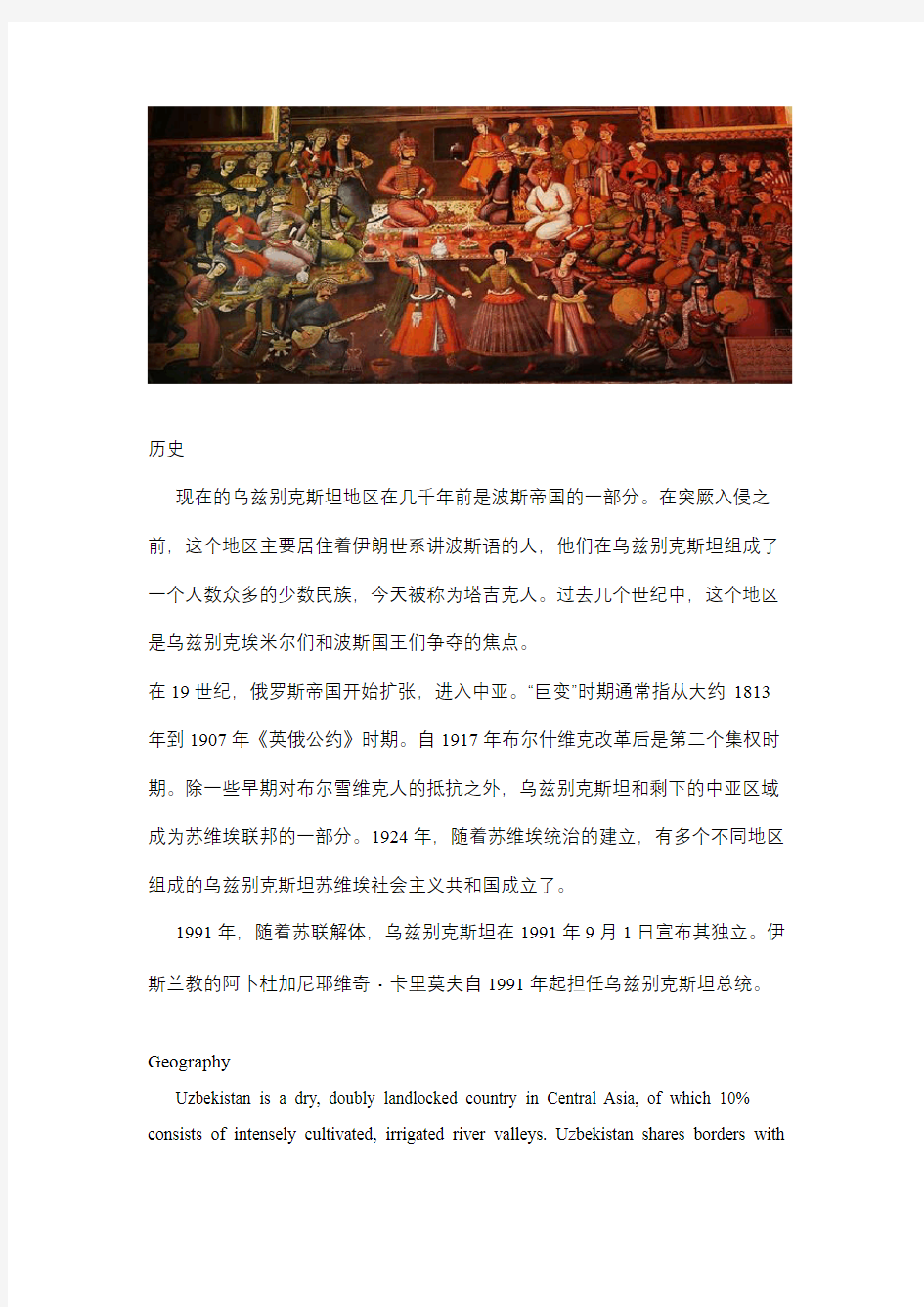史上最全 乌兹别克斯坦 中英双语介绍


史上最全乌兹别克斯坦中英双语介绍
History
For thousands of years the present area of Uzbekistan was a part of the Persian Empire. Before the gradual arrival of the Turkic invaders the area was populated by the Persian-speaking people of Iranian stock who still comprise a large minority in Uzbekistan and are called Tajiks today. The area was a bone of contention between the Uzbek emirs and the Persian Kings for many centuries.
In the 19th century, the Russian Empire began to expand, and spread into Central Asia. The "Great Game" period is generally regarded as running from approximately 1813 to the Anglo-Russian Convention of 1907. Following the Bolshevik Revolution of 1917 a second less intensive phase followed. Despite some early resistance to Bolsheviks, Uzbekistan and the rest of Central Asia became a part of the Soviet Union. In 1924, following the establishment of Soviet rule, the Soviet Socialist Republic of Uzbekistan was founded from various territories.
In 1991, with the breakup of the Soviet Union, Uzbekistan reluctantly declared its independence on 1 September 1991. Islam Abduganievich Karimov has been the President of Uzbekistan since 1991.
历史
现在的乌兹别克斯坦地区在几千年前是波斯帝国的一部分。在突厥入侵之前,这个地区主要居住着伊朗世系讲波斯语的人,他们在乌兹别克斯坦组成了一个人数众多的少数民族,今天被称为塔吉克人。过去几个世纪中,这个地区是乌兹别克埃米尔们和波斯国王们争夺的焦点。
在19世纪,俄罗斯帝国开始扩张,进入中亚。“巨变”时期通常指从大约1813
年到1907年《英俄公约》时期。自1917年布尔什维克改革后是第二个集权时期。除一些早期对布尔雪维克人的抵抗之外,乌兹别克斯坦和剩下的中亚区域成为苏维埃联邦的一部分。1924年,随着苏维埃统治的建立,有多个不同地区组成的乌兹别克斯坦苏维埃社会主义共和国成立了。
1991年,随着苏联解体,乌兹别克斯坦在1991年9月1日宣布其独立。伊斯兰教的阿卜杜加尼耶维奇?卡里莫夫自1991年起担任乌兹别克斯坦总统。
Geography
Uzbekistan is a dry, doubly landlocked country in Central Asia, of which 10% consists of intensely cultivated, irrigated river valleys. Uzbekistan shares borders with
Kazakhstan to the west and to the north, Kyrgyzstan and Tajikistan to the east, and Afghanistan and Turkmenistan to the south.
It is one of two double-landlocked countries in the world - the other being Liechtenstein, although in the case of Uzbekistan this is less clear, since it has borders with two countries (Kazakhstan in the north and Turkmenistan in the south) bordering the landlocked but non-freshwater Caspian Sea from which ships can reach the Sea of Azov and thus the Black Sea, the Mediterranean Sea and the oceans. The highest point in Uzbekistan is Adelunga Toghi at 4301 m.
地理
乌兹别克斯坦位于中亚,是一个干旱的双重内陆国家,10%的地区有密集的耕地、水渠和山谷。乌兹别克斯坦西部与卡萨克斯坦接壤,东靠吉尔吉斯和塔吉克斯坦,南部是阿富汗和土库曼斯坦。
世界上有两个双重内陆国家,另一个是列支敦士登。乌兹别克斯坦它与两个国家交界(北边哈萨克斯坦,南边土库曼斯坦),被陆地封锁,但船只可穿过非淡水的里海,到达亚速海,黑海和地中海,抵达海洋。乌兹别克斯坦的最高点是Adelunga toghi ,4301米。
Political System
The President is the chief of state. The president is elected by popular votes for a seven-year term. The prime minister is the head of government. The prime minister and deputy ministers are appointed by the president. The Cabinet of Ministers is appointed by the president with the approval of the Supreme Assembly.
It used to have a unicameral Supreme Assembly or Oliy Majlis (250 seats; members elected by popular vote to serve five-year terms). On 27 January 2002, a referendum was held to make the Assembly bicameral on the 2004 elections. The bicameral parliament consists of a lower house (the Oliy Majlis) and an upper house (Senate). Members of the lower house are to be "full time" legislators. Elections for the new bicameral parliament took place on 26 December 2004.
政治体系
总统是国家元首。总统由民众投票选举,任期七年。总理是政府的首脑。总理和副总理由总统任命。总理内阁由总统经最高审议机构同意后任命。以前,它有一个一院制的最高审议机构最高会议称为Oliy Majlis(250个席位;成员由民众选举,任期5年)。2002年1月27日举行了公民表决,决定在2004年实
行两院制议会。两院制的议会由下议院(the Oliy Majlis)和上议院(Senate)组成。下议院的成员是全职立法者。新的两院制议会选举于2004年12月26日举行。
Education System
The educational system has achieved 97% literacy, and the mean amount of schooling for both men and women is 11 years. However, due to budget constraints and other transitional problems following the collapse of the Soviet Union, texts and other school supplies, teaching methods, curricula, and educational institutions are outdated, inappropriate, and poorly kept. Additionally, the proportion of school-aged persons enrolled has been dropping. Although the government is concerned about this, budgets remain tight.
教育体系
这个教育体系能达到97%的识字率,男女平均学年为11年。然而,由于预算紧缩和苏联解体带来的过渡性问题,教科书、学校设施、教学方式、教学科目、教育机构都是落后的,不合时宜的勉强维持。另外,达到入学年龄人的入学率也在下降。虽然,政府注意到了这些问题,但预算仍然紧张。
Population
Uzbekistan has an estimated population of 25 million. It is Central Asia’s most populous country. It The population are concentrated in the south and east of the country, are nearly half the region’s total population. Uzbekistan had been one of the poorest republics of the Soviet Union; much of its population was engaged in cotton farming in small rural communities. The population continues to be heavily rural and dependent on farming for its livelihood. Uzbek is the predominant ethnic group. Other ethnic groups include Russian 5.5%, Tajik 15%, Korean 4.7%, Kazakh 3%, Karakalpak 2.5%, and Tatar 1.5%.
人口
乌兹别克斯坦大约有人口2千5百万,是中亚人口最密集的国家。它的人口主要集中于国家的南部和东部,几乎占原住居民人口总数的一半。乌兹别克斯坦过去一直是苏联最穷的共和国之一,很多人口在狭小的农业区从事棉花种植业。人口严重农村化,生存手段主要依赖于农耕。乌兹别克人是主要的种群, 占总人口的80%,另外的种群包括俄罗斯人5.5%,塔吉克人15%,韩国人
4.7%,哈萨克人3%,卡拉卡尔帕克人2.5%,和塔塔尔人1.5%。
Capital Tashkent (Toshkent)
首都塔什干
Languages
Uzbek is the official state language; however, Russian is the de facto language for interethnic communication, including day-to-day government and business use.
语言
乌兹别克语是官方的国家语言。而俄罗斯语是各民族间沟通的语言,在政府例行事务和日常工作中使用。
Religions The nation is of 88% Muslim and 9% Eastern Orthodox.
宗教信仰国家有88%人信穆斯林,9%信东正教。
Economy
Uzbekistan is now the world’s third largest cotton exporter, a major producer of gold and natural gas, and a regionally significant producer of chemicals and
